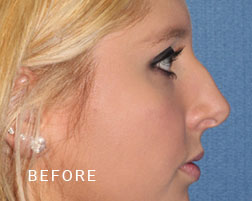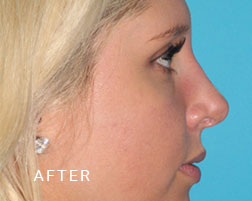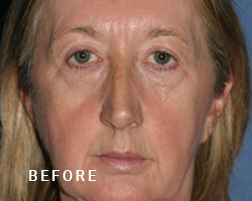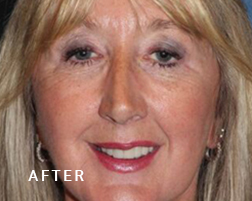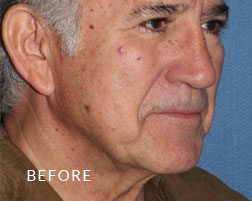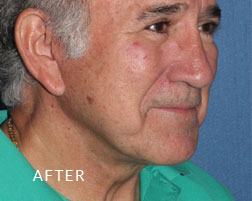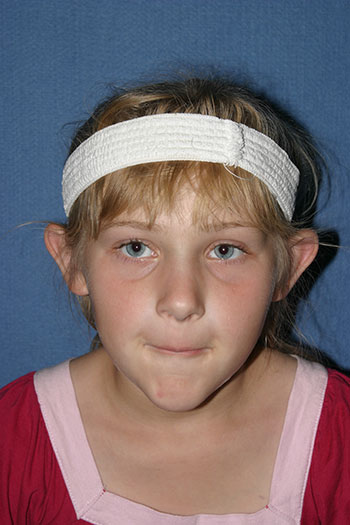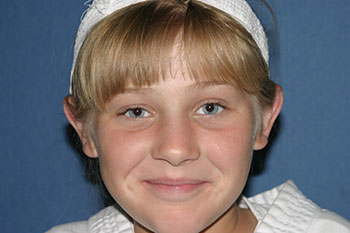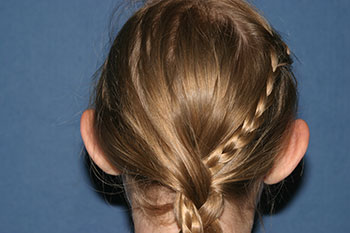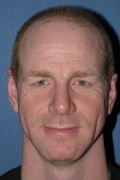Otoplasty (Ear Pinning)
Offered at our convenient location in Scottsdale, Arizona
Facial symmetry is achieved in facial plastic surgery by utilizing aesthetic principles and techniques to frame and balance the face. One of the anatomical regions which contributes heavily to facial symmetry is the appearance and position of the ears. The ears can play aa very large role in other peoples’ perceptions of you. Otoplasty is the surgical sculpting of the outer ear to achieve a more appealing shape as well as moving the ear closer to the scalp. Children are common candidates for the procedure. Many adults also elect ear pinning if they were not able to address the issue in their younger years.
If your ears are protruding, overly large, or otherwise misshapen, they might be a significant target for ridicule. Perhaps you or a child in your care are all too aware of this obvious fact: big ears can make you a target for adolescent pranks. Dr. Wolin hears you and he wants to help.
Dr. Andrew Wolin provides premium aesthetic care to an ever-growing cavalcade of loyal and satisfied patients. He proudly serves the people of Scottsdale, Arizona, and its surrounding communities.
Consider an otoplasty consultation. To contact us, call (480) 945-8440. We now offer remote appointments through Zoom video conferencing.
Contents
About Otoplasty

Otoplasty is a surgical procedure to improve the appearance of protruding ears. “Protruding ears” are a legitimate diagnosis for ears that extend beyond two centimeters from the head. The condition is usually caused by an overdeveloped concha, which is the deep hollow of the outer ear near the ear canal.
Genetics contribute significantly to protruding ears. It is often easy to observe the troublesome trait recurring through the generations of a family.[1]
Common Traits of Ear Pinning Patients
- Ears that are disproportionately large
- Ears that sit asymmetrically on the head
- Protruding ears that extend more than two centimeters from the surface of the scalp.
Especially large ears can be a source of torment in adolescents. Since the condition is treatable in youth, school-aged children make up a large portion of otoplasty patients. Many young adults also seek out cosmetic enhancement with ear surgery.
Before and After Photos
Benefits
Ear surgery will improve the self-esteem of patients at any age. If you are a parent, it may delight you to learn that it is safe to perform otoplasty on children starting at age five, when the majority of ear growth has been completed.
Spread the word. Protruding ears’ genetic link could mean a closely related family member might benefit from ear surgery, as well.[2]
- Enhances appearance and self-esteem
- The outpatient procedure is performed under local anesthesia (in adults)
- Minimal scarring
- Long-lasting results
Candidates
Qualified candidates for ear surgery range in age from five years old to late adulthood. The surgery’s ease and short recovery make it a “sooner-the-better” kind of operation. Many parents opt for otoplasty if they are able to provide it to their children. Adults seeking ear surgery often had to forego the procedure when they were younger until they could properly pursue it independently as a financially solvent grownup.
Your Private Consultation Dr. Wolin
Dr. Andrew Wolin is a double board-certified Plastic Surgeon as well as a fully trained Ear, Nose and Throat Surgeon. Over his 30 years in practice, he has done hundreds of corrective ear surgeries on adults as well as children, With a widely respected practice conveniently located in Scottsdale, Arizona. Wolin Plastic Surgery Center is a beacon of comfort and a benchmark for competence in the Greater Phoenix Area.
Begin a conversation that could lead to a new you. Call (480) 945-8440 to schedule your personal consultation with Dr. Wolin. We now offer remote appointments through Zoom video conferencing.
How Does Ear Surgery Work?
Otoplasty is an outpatient procedure that can last up to two hours. The extent of your surgery may vary based on the complexity of your case. Adults may only require a local anesthetic.
Ear surgery is safe and easy on the patient. Its small incisions are very well concealed within the distinctive creases of the ear.[3] Dr. Wolin removes excess cartilage and skin, as needed, to achieve the desired shape and orientation. Ear-pinning may involve permanent sutures to hold the ears in an appealing position flush against both sides of the head.
Otoplasty Procedure
- Dr. Wolin makes an incision behind both ears
- He removes excess skin and cartilage to sculpt the ears
- Sutures are used to “pin” the ears in place
- Dr. Wolin closes his incisions and applies bandages to the site
As your otoplasty concludes, the doctor will place light dressings at the surgery site. He will prescribe a compression headband to place over your ears. For a few days, you may look like you just left the tennis court but your headband will promote adequate molding and maintain optimal ear placement.
Follow Dr. Wolin’s personalized aftercare instructions carefully to avoid infection and maximize your results. Your pleasing results will endure for many years to come!
How Long is Ear Pinning Recovery?
Dr. Wolin will remove your sutures after week one. Avoid strenuous activity for two weeks after surgery. It is common to have some numbness at the ears, however, it should resolve within one to two months.
During the first two weeks of your recuperation, your compression headband will hold your delicate healing features in place. Your surgeon may have you sleep on elevated pillows, rather than your sides, to avoid putting any additional pressure on your ears. The biggest risk at this stage is damaging your surgical correction. So, you will wear your protective headband at all times during the day for the first post-operative week. You will then continue to wear it at night, for approximately 3 weeks.
Your ear surgery recovery will follow your unique timeline of milestones, punctuated by the universal features of the healing process.
Your ears will be tender, swollen and red for several weeks. You may experience some bruising. Expect mild discomfort, itching, swelling and throbbing. You can control these symptoms with oral pain medications.
After four to six weeks, you’ll be able to resume all normal activities, including sports. Please be mindful of your surgical site. Any undue trauma may result in less-than-optimal outcomes that will require future revision surgeries. Nearly all of the swelling should subside after three months.
By the one year anniversary of your surgery day, your newly-shaped ears should be fully healed and looking great.
Anticipated Results
Ear surgery is a long-lasting solution for overly large ears. It is a relatively simple procedure with a short recovery time. Once your incisions have fully healed and your cartilage has set, your ears will not go back to where they were prior to otoplasty.
What Does Otoplasty Cost in the Greater Phoenix Area?
Ear surgery is a customized procedure that is tailored to the individual. At your personal consultation, Dr. Wolin will listen to your story and consider his approach. After he reviews your medical history and examines your ears with his own eyes, Dr. Wolin will propose a course of treatment designed to help you reach your aesthetic goals. At such time, he shall provide you a cost estimate.
Dr. Wolin is a thought leader in plastic surgery. His aesthetic expertise and medical authority are spotlighted in his frequent media appearances. Call (480) 945-8440 to schedule your consultation with one of Arizona’s best.
The Aesthetics of Framing
Thanks to genetics, you may have already learned the hard way that growing up with big ears isn’t any fun. But you can break the bullying cycle today because your child’s protruding ears can be easily corrected. All it takes is a simple ear pinning procedure to balance the facial features. A carefully orchestrated otoplasty can save some socially ostracized children from a lonely adolescence.
Our adult patients often wonder why they waited so long once they see how easy ear surgery can be!
FAQ
Is ear pinning permanent?
Once your ears heal in place, otoplasty’s improvements are permanent. That’s because small amounts of skin and cartilage are actually removed to achieve the aesthetic effect. Certainly, cartilage may continue to grow as you get older, but your ears will not protrude as they once did.
What causes ears to stick out?
Protruding ears can be caused by an underdeveloped antihelical fold of the outer ear. In some people, the antihelical fold does not form correctly, so the outer rim of the ear sticks out. People with protruding ears also have a deep concha, which is the bowl-shaped space just outside the opening of the ear canal. A deep concha will push the entire ear away from the side of the head. Although protruding ears don’t cause any functional problems with hearing, children may pay a heavy social cost if they are relentlessly teased by others.
Are there alternatives to otoplasty?
You might reasonably seize a feasible alternative to otoplasty if you identify the protrusion before your child is three months old. At this time, you can apply ear molds while the baby’s cartilage is still developing. After this crucial age window, however, ear pinning is your only option. Fortunately, ear surgery is safe and easy on the patient. It is performed on people of all ages, from five-year-old children to full-grown adults. Overall, otoplasty has high rates of satisfaction because it grants patients control and correction over one of their most embarrassing features.
References
- Niamtu, J. (2018). Cosmetic Otoplasty and Related Ear Surgery. Cosmetic Facial Surgery, 473–532. doi: 10.1016/b978-0-323-39393-5.00008-x
- Otoplasty. (2018, August 14). Retrieved January 6, 2020, from https://www.mayoclinic.org/tests-procedures/otoplasty/about/pac-20394822.
- Litschel, R., Majoor, J., & Tasman, A. (2015). Effect of Protruding Ears on Visual Fixation Time and Perception of Personality. JAMA Facial Plastic Surgery, 17(3), 183. doi:10.1001/jamafacial.2015.0078




